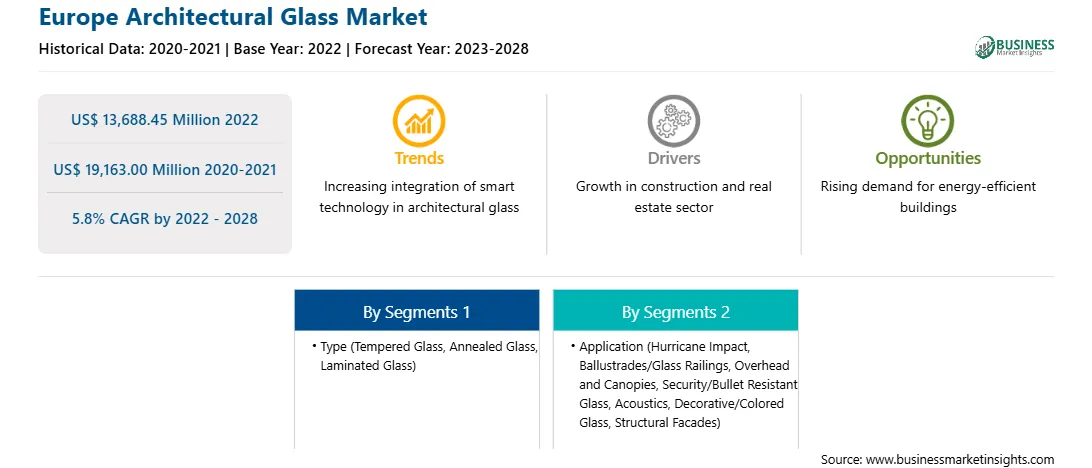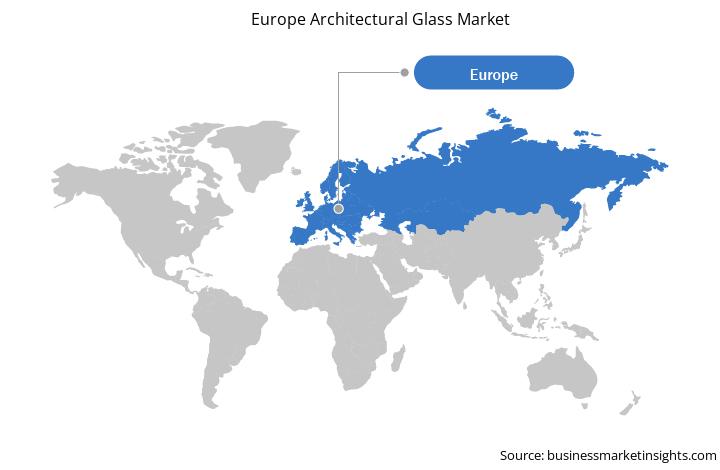Rise in Consumer Expenditure on Interior Designing is Driving the Europe Architectural Glass Market
Consumer spending on interior designing is increasing due to the rising income levels, increasing urbanization, and growing population. Other factors that lead to a surge in demand for Interior designing services include the influence of social media, smart homes, and changes in the lifestyle of the people and living standards. The growth in interior design is correlated with the growing global real estate market. Moreover, Houzz—the online platform that connects home renovators with interior designers, professional tradespeople, and home decor suppliers—reported that home renovation pros received 102% more enquires in August 2020 than same month in 2019. Many product categories also saw huge increases. Thus, the increasing consumer spending on interior design is further expected to boost the demand for architectural glass. Furthermore, people choose a theme-based interior design for their commercial and residential spaces. Themes such as the Mediterranean Style, the Ethnic Indian Style of Design & Décor, and the European Style are getting common nowadays. Innovations in interior design are taking place to make homes more tech friendly. Virtual reality is disrupting the interior designing industry and has made visualizing and experimenting processes easy for clients and designers. However, the cost of using this technology is high for incorporation into the industry. Comscore data has revealed that many people who were confined to their homes as a result of the COVID-19 pandemic had chosen to take on home repair projects they may have put off in the past. Such an increase in the visit indices shows consumers wiliness to spend on interior designing is projected to drive the Europe architectural glass market.
Europe Architectural Glass Market Overview
Europe is a diverse market that includes several developed and developing economies such as Germany, France, Italy, the UK, Spain, and Russia. The region is home to several major architectural glass manufacturers such as Saint-Gobain, Schott, and AGC Inc. The manufacturers are involved in the strategic expansion and product development to meet the rising demand for architectural glass from end-use industries. For instance, in February 2022, AGC Inc invested ~US$ 10.57 million in its laminating line to be installed in its Osterweddingen Plant (Germany). This development in the company’s Architectural Glass Division—aimed to meet the growing demand for architectural glass—provides safety, security, acoustic comfort, daylight, and high-performance glazing. Moreover, the surge in requirement for energy efficiency and the rise in building renovations in the past few years are creating business opportunities for architectural glass in the region. Further, the rising investments in solar power plant infrastructure are boosting the demand for architectural laminated glass, as the glass is utilized for embedding photovoltaic cells in solar panels. For instance, in 2021, a solar power plant of 300–350 MW capacity was constructed by the Government of North Macedonia in collaboration with Elektrani na Severna Makedonija (ESM). Furthermore, the country is planning to expand its solar power plant capacity to 400 MW by the end of 2024. Hence, product developments by key players, coupled with a surge in investments in solar power projects, are projected to boost the Europe architectural glass market in the coming years.

Strategic insights for the Europe Architectural Glass provides data-driven analysis of the industry landscape, including current trends, key players, and regional nuances. These insights offer actionable recommendations, enabling readers to differentiate themselves from competitors by identifying untapped segments or developing unique value propositions. Leveraging data analytics, these insights help industry players anticipate the market shifts, whether investors, manufacturers, or other stakeholders. A future-oriented perspective is essential, helping stakeholders anticipate market shifts and position themselves for long-term success in this dynamic region. Ultimately, effective strategic insights empower readers to make informed decisions that drive profitability and achieve their business objectives within the market.

| Report Attribute | Details |
|---|---|
| Market size in 2022 | US$ 13,688.45 Million |
| Market Size by 2028 | US$ 19,163.00 Million |
| Global CAGR (2022 - 2028) | 5.8% |
| Historical Data | 2020-2021 |
| Forecast period | 2023-2028 |
| Segments Covered |
By Type
|
| Regions and Countries Covered | Europe
|
| Market leaders and key company profiles |
The geographic scope of the Europe Architectural Glass refers to the specific areas in which a business operates and competes. Understanding local distinctions, such as diverse consumer preferences (e.g., demand for specific plug types or battery backup durations), varying economic conditions, and regulatory environments, is crucial for tailoring strategies to specific markets. Businesses can expand their reach by identifying underserved areas or adapting their offerings to meet local demands. A clear market focus allows for more effective resource allocation, targeted marketing campaigns, and better positioning against local competitors, ultimately driving growth in those targeted areas.

Europe Architectural Glass Market Segmentation
The Europe architectural glass market is segmented into type, application, and country.
Based on type, the Europe architectural glass market is segmented into tempered glass, annealed glass, laminated glass, and others. In 2022, the laminated glass segment registered a largest share in the Europe architectural glass market.
Based on application, the Europe architectural glass market is segmented into hurricane impact, ballustrades/glass railings, overhead and canopies, security/bullet resistant glass, acoustics, decorative/colored glass, structural facades, and others. In 2022, the structural facades segment registered a largest share in the Europe architectural glass market.
Based on country, the Europe architectural glass market is segmented into Germany, France, Italy, UK, Russia, and the Rest of Europe. In 2022, the Rest of Europe segment registered a largest share in the Europe architectural glass market.
AGC Inc; Asahi India Glass Ltd; Compagnie de Saint-Gobain SA; Guardian Industries Holdings LLC; Jinjing (Group) Co Ltd, Nippon Sheet Glass Co Ltd; Schott AG; Turkiye Sise ve Cam Fabrikalari AS; and Vitro SAB de CV are the leading companies operating in the Europe architectural glass market.
The Europe Architectural Glass Market is valued at US$ 13,688.45 Million in 2022, it is projected to reach US$ 19,163.00 Million by 2028.
As per our report Europe Architectural Glass Market, the market size is valued at US$ 13,688.45 Million in 2022, projecting it to reach US$ 19,163.00 Million by 2028. This translates to a CAGR of approximately 5.8% during the forecast period.
The Europe Architectural Glass Market report typically cover these key segments-
The historic period, base year, and forecast period can vary slightly depending on the specific market research report. However, for the Europe Architectural Glass Market report:
The Europe Architectural Glass Market is populated by several key players, each contributing to its growth and innovation. Some of the major players include:
The Europe Architectural Glass Market report is valuable for diverse stakeholders, including:
Essentially, anyone involved in or considering involvement in the Europe Architectural Glass Market value chain can benefit from the information contained in a comprehensive market report.